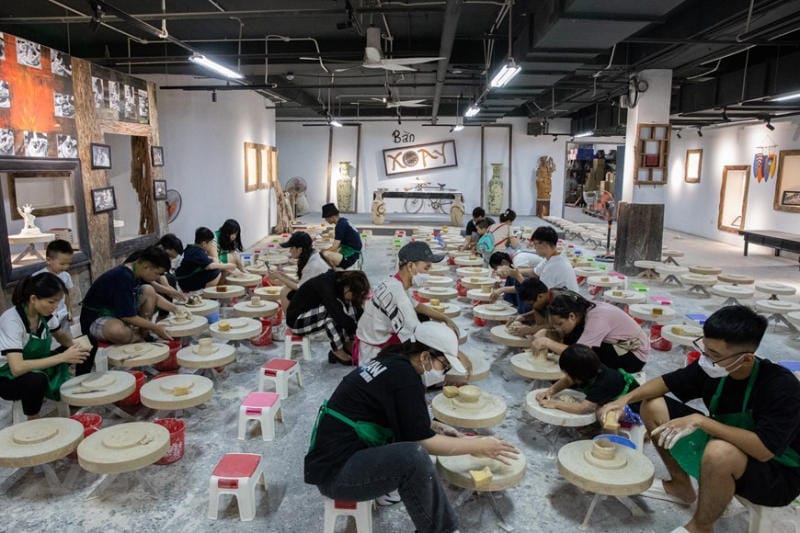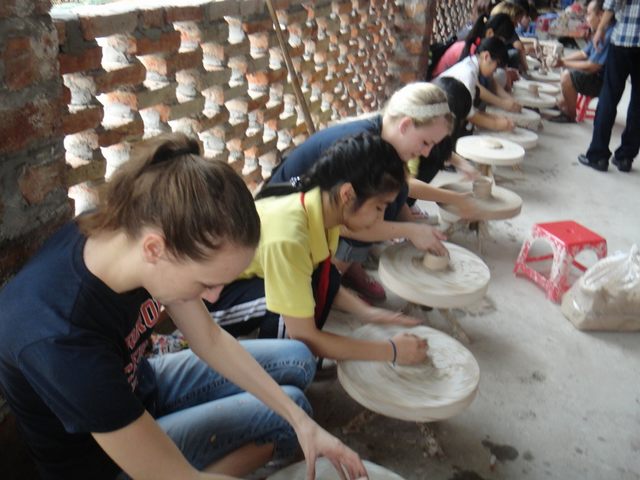News
Face the Challenges Facing Artisans of Bat Trang Ceramics
Bat Trang ceramics, a treasured cultural heritage from Vietnam, have stood the test of time due to their exquisite craftsmanship and artistic value. This centuries-old tradition, originating from the Bat Trang village near Hanoi, is renowned for its distinct style, quality, and historical significance. Yet, despite its rich legacy and global recognition, artisans producing Bat Trang ceramics face multifaceted challenges in the modern era. These challenges threaten not only individual livelihoods but also the survival of a unique art form that embodies Vietnamese heritage.
The following exploration dives deep into the myriad hurdles confronting Bat Trang ceramics artisans today—from economic pressures and competition to technological changes and environmental concerns. Through detailed analysis, this article aims to illuminate the complexities these artists grapple with as they strive to preserve and innovate within their craft.
Bat Trang Ceramics – Economic Pressures and Market Competition

In an increasingly globalized market, Bat Trang artisans must navigate a complex terrain where traditional craftsmanship collides with mass-produced goods. The economic pressures on artisans stem from fluctuating demand, rising production costs, and fierce competition both domestically and internationally.
Understanding these dynamics is crucial to identifying sustainable pathways for Bat Trang ceramics’ future.
Impact of Globalization on Local Craftsmanship
Globalization has created opportunities for Bat Trang ceramics to reach international markets, yet it also exposes local artisans to competition from cheaper, industrially manufactured ceramics. While Bat Trang products are valued for their artisanal quality, many consumers prioritize cost over authenticity.
Artisans often find themselves competing against factories that use automated processes, enabling them to produce large quantities of ceramics at lower prices. This disparity makes it difficult for handcrafted Bat Trang ceramics to maintain market share, especially in lower-income segments.
Moreover, globalization brings cultural dilution risks. As foreign tastes influence design preferences, some artisans may feel pressured to alter traditional patterns, potentially eroding the cultural identity embedded in Bat Trang ceramics. Balancing commercial viability with heritage preservation is thus a delicate task.
Rising Costs of Raw Materials and Production
Another significant challenge lies in the escalating costs of raw materials such as clay and glaze ingredients. Over the years, mining restrictions and environmental regulations have limited access to high-quality natural clay sources near Bat Trang. This scarcity drives up material costs, squeezing artisan profit margins.
Additionally, labor expenses have increased as younger generations seek alternative employment outside the ceramics industry. Maintaining skilled workers becomes a costly endeavor when wages rise without a corresponding increase in product prices.
Energy costs for firing kilns add another layer of financial burden. Traditional wood or coal-fired kilns are being phased out or restricted for environmental reasons, requiring investment in more expensive electric or gas kilns. Such capital-intensive upgrades can be prohibitive for small-scale artisans.
Competition from Mass-Produced Imitations
Mass-produced imitation Bat Trang ceramics flood both local and export markets, undermining the reputation and sales of genuine handcrafted pieces. These imitations often mimic Bat Trang’s recognizable motifs but lack the authenticity, durability, and artistic nuance of true artisanship.
This counterfeit market creates confusion among consumers, dilutes brand value, and diverts demand away from original producers. Many artisans struggle to distinguish their products adequately, due to limited marketing resources and digital presence.
Efforts to establish geographical indication (GI) protections and official trademarks for Bat Trang ceramics have helped somewhat, but enforcement remains challenging. Without rigorous legal frameworks and consumer education, fighting counterfeit goods continues to be an uphill battle.
Preservation of Traditional Skills and Knowledge Transmission

The survival of Bat Trang ceramics depends heavily on the transmission of specialized skills and knowledge across generations. However, modernization and demographic shifts pose serious threats to this process, risking the loss of invaluable craftsmanship techniques.
Examining how artisans sustain and evolve their expertise reveals deeper tensions between tradition and change.
Declining Interest Among Younger Generations
One of the most pressing issues is the decreasing interest of youth in pursuing careers as ceramic artisans. Many young people view ceramics production as labor-intensive, low-paying, and lacking prestige compared to urban or technology-related jobs.
As a result, fewer apprentices are willing to undergo the long, meticulous training required to master Bat Trang techniques. This demographic shift leads to a critical gap in skill transfer, endangering continuity.
Furthermore, migration to cities for education or employment reduces the human capital available in Bat Trang village. Families with tradition in ceramics often encourage their children toward alternative professions, causing those crafts to dwindle.
Challenges in Formalizing and Modernizing Training
Traditional apprentice-based learning methods remain predominant in Bat Trang. While this hands-on approach ensures intimate knowledge of materials and processes, it lacks formalized curriculum or certification systems that could elevate professional standards.
Introducing modern training programs blending theory, history, business skills, and innovative techniques could attract young talent and improve quality. Yet, developing such institutional support requires coordination among government bodies, educational institutions, and artisan communities—a complex undertaking.
Moreover, integrating technology into training, such as virtual simulations or digital documentation, offers promising avenues for preserving and disseminating knowledge while making learning more accessible and appealing.
Balancing Innovation With Heritage Integrity
Innovation is essential for Bat Trang ceramics to adapt to contemporary markets, but it must be carefully balanced to avoid compromising core traditional elements. Experimenting with new shapes, glazes, or decoration techniques can rejuvenate interest, yet straying too far from established styles risks alienating loyal customers and weakening cultural identity.
Artisans face the challenge of innovating within boundaries that honor Bat Trang’s aesthetic and symbolic values. This calls for thoughtful dialogue between elder masters and emerging artists, fostering creativity anchored in respect for origins.
Encouraging participatory workshops, exhibitions, and cultural exchanges can nurture this balance by providing platforms for sharing ideas while reinforcing collective heritage.
Environmental Sustainability and Resource Management

Environmental concerns increasingly influence the production of Bat Trang ceramics. Sustainable resource management is paramount for ensuring the longevity of both natural materials and artisan livelihoods in the face of ecological constraints.
Exploring the intersection of craftsmanship and environmental responsibility sheds light on vital steps needed for sustainable development.
Depletion and Conservation of Natural Clay Sources
The distinctive appeal of Bat Trang ceramics largely depends on the unique qualities of local clay deposits. However, ongoing mining activities risk depleting these finite resources, threatening the availability of premium raw materials.
Unregulated extraction can cause soil erosion, habitat destruction, and pollution, further damaging the ecosystem around Bat Trang village. To counteract this, conservation initiatives aim to regulate clay mining, promote responsible sourcing, and rehabilitate depleted areas.
Artisans and community leaders increasingly recognize that maintaining ecological balance is not just an environmental concern but fundamental to sustaining their craft. Collaborative efforts with environmental agencies can lead to sustainable quarrying practices combined with reforestation and land restoration projects.
Transition to Eco-Friendly Firing Techniques
Traditional firing methods such as wood or coal kilns contribute significantly to air pollution, emitting particulate matter and greenhouse gases. Modern environmental standards necessitate a transition towards cleaner technologies.
Electric or gas kilns offer reduced emissions and improved temperature control, enhancing product consistency. However, their energy consumption and initial costs present practical barriers for many artisans.
Research into alternative fuels like biomass pellets or solar-assisted kilns holds promise for greener production. Encouraging adoption through subsidies, training, and technical support can accelerate the shift while preserving the integrity of ceramic firing processes.
Waste Reduction and Recycling in Production
Ceramic production generates waste including broken pieces, glaze residues, and used packaging materials. Effective waste management minimizes environmental impact and improves operational efficiency.
Recycling clay scraps by crushing and reprocessing them reduces raw material demand. Implementing systematic sorting and collection of waste supports circular economy principles.
Additionally, exploring biodegradable packaging options and reducing plastic usage aligns Bat Trang ceramics with contemporary sustainability expectations, appealing to environmentally conscious consumers.
Educating artisans about eco-friendly practices and providing practical tools fosters a culture of sustainability integral to the craft’s future.
Marketing Strategies and Digital Transformation
In a digitally driven marketplace, Bat Trang ceramics artisans must harness modern marketing strategies to expand visibility, reach new customers, and enhance competitiveness. Strategic adaptation to digital platforms and branding innovations is critical to revitalizing the industry.
This section delves into how embracing digital transformation can empower artisans.
Leveraging Social Media and E-Commerce Platforms
Social media channels such as Facebook, Instagram, and TikTok offer powerful tools for showcasing Bat Trang ceramics’ artistry to global audiences. Visual storytelling, live demonstrations, and customer testimonials create engaging content that resonates beyond traditional retail settings.
E-commerce platforms provide direct sales opportunities, bypassing intermediaries and increasing profit margins. Online marketplaces enable artisans to access international buyers who appreciate authentic handmade products.
However, effective use of these tools requires digital literacy, marketing know-how, and consistent content creation—skills many artisans currently lack. Partnerships with tech-savvy youth or professional marketers can bridge this gap.
Developing Strong Brand Identity and Geographical Indication
Building a strong brand identity rooted in Bat Trang’s history, craftsmanship standards, and cultural symbolism differentiates products from generic competitors. Clear storytelling about production processes, artisan profiles, and cultural significance adds emotional value.
Geographical indication (GI) certification serves as a seal of authenticity, protecting Bat Trang ceramics from imitations. Promoting GI status through labeling and awareness campaigns increases consumer trust and willingness to pay premium prices.
Collaborative branding efforts among artisans, cooperatives, and local authorities amplify impact, creating unified messaging that enhances market positioning.
Organizing Cultural Events and Workshops
Interactive events such as exhibitions, pottery workshops, and cultural festivals provide immersive experiences that deepen appreciation for Bat Trang ceramics. Tourists and collectors gain firsthand insight into artisanal skills, fostering brand loyalty.
These events generate supplementary income streams and opportunities for direct feedback. Showcasing innovation alongside tradition attracts diverse audiences and media attention.
Investing in event management and hospitality training equips artisans to host successful public engagements, turning Bat Trang ceramics into a vibrant cultural tourism asset.
| Challenge Category | Key Issues | Potential Solutions | Stakeholders Involved |
|---|---|---|---|
| Economic Pressures | High production costs, market competition | GI protection, subsidies, fair trade promotion | Artisans, government, NGOs |
| Skill Preservation | Youth disinterest, informal training | Formal education programs, apprenticeships | Educational institutions, artisan guilds |
| Environmental Sustainability | Clay depletion, pollution | Sustainable mining, eco-friendly kilns | Environmental agencies, artisans |
| Marketing Digital Adaptation | Limited online presence, weak branding | Social media strategy, e-commerce integration | Marketing experts, artisan cooperatives |
Conclusion
Facing the challenges that beset the artisans of Bat Trang ceramics demands a multifaceted approach encompassing economic resilience, cultural preservation, environmental stewardship, and strategic modernization. As globalization intensifies competition, sustaining traditional skills and adapting to market realities require concerted efforts from artisans, communities, policymakers, and consumers alike. By embracing sustainable practices, enhancing training and innovation, and leveraging digital tools and branding, Bat Trang ceramics can revitalize their legacy for future generations. Ultimately, safeguarding this rich craft is not merely about preserving objects but nurturing the living heritage and identity they embody.
